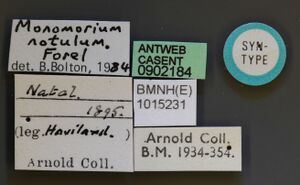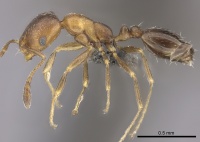Monomorium notulum
| Monomorium notulum | |
|---|---|

| |
| Scientific classification | |
| Kingdom: | Animalia |
| Phylum: | Arthropoda |
| Class: | Insecta |
| Order: | Hymenoptera |
| Family: | Formicidae |
| Subfamily: | Myrmicinae |
| Tribe: | Solenopsidini |
| Genus: | Monomorium |
| Species: | M. notulum |
| Binomial name | |
| Monomorium notulum Forel, 1910 | |
| Synonyms | |
| |
This species inhabits open, e.g. grasslands, and semi-open, e.g. open woodland, areas.
Identification
Bolton (1987) - A member of the M. setuliferum species group. Very closely related to Monomorium ebangaense, notulum is separated only by the minor sculptural characters noted in the key and its slightly larger eyes. Both of these are close to, and perhaps inseparable from, Monomorium setuliferum where the eyes are larger still but tend to be distinctly reniform in shape . Within the bounds of the setuliferum-group, these three forms are distinguished by their dense blanketing sculpture and very reduced dorsal pilosity.
Keys including this Species
Distribution
Latitudinal Distribution Pattern
Latitudinal Range: -17.93333° to -30.7°.
| North Temperate |
North Subtropical |
Tropical | South Subtropical |
South Temperate |
- Source: AntMaps
Distribution based on Regional Taxon Lists
Afrotropical Region: Angola, Namibia, South Africa (type locality), Zimbabwe, Zimbabwe.
Distribution based on AntMaps
Distribution based on AntWeb specimens
Check data from AntWeb
Countries Occupied
| Number of countries occupied by this species based on AntWiki Regional Taxon Lists. In general, fewer countries occupied indicates a narrower range, while more countries indicates a more widespread species. |

|
Estimated Abundance
| Relative abundance based on number of AntMaps records per species (this species within the purple bar). Fewer records (to the left) indicates a less abundant/encountered species while more records (to the right) indicates more abundant/encountered species. |

|
Biology
Castes
Worker
Images from AntWeb
   
| |
| Syntype of Monomorium notulum. Worker. Specimen code casent0902184. Photographer Will Ericson, uploaded by California Academy of Sciences. | Owned by NHMUK, London, UK. |
Nomenclature
The following information is derived from Barry Bolton's Online Catalogue of the Ants of the World.
- notulum. Monomorium setuliferum var. notula Forel, 1910e: 441 (w.m.) SOUTH AFRICA.
- Type-material: syntype workers, syntype males (numbers not stated).
- Type-locality: South Africa: Natal (Haviland).
- Type-depository: MHNG.
- Subspecies of setuliferum: Forel, 1913a: 137; Arnold, 1916: 228; Wheeler, W.M. 1922a: 872; Emery, 1922e: 174; Santschi, 1936a: 39; Ettershank, 1966: 91.
- Status as species: Bolton, 1987: 370 (redescription); Bolton, 1995b: 265.
- Senior synonym of dolichops: Bolton, 1987: 370; Bolton, 1995b: 265.
- Senior synonym of latior: Bolton, 1987: 370; Bolton, 1995b: 265.
- Distribution: Angola, South Africa, Zimbabwe.
- dolichops. Monomorium (Xeromyrmex) setuliferum var. dolichops Santschi, 1928f: 194 (w.) ZIMBABWE.
- Type-material: syntype workers (number not stated).
- Type-locality: Zimbabwe (“Southern Rhodesia”): Victoria Falls (G. Arnold).
- Type-depository: NHMB.
- Subspecies of setuliferum: Santschi, 1936a: 39; Ettershank, 1966: 88.
- Junior synonym of notulum: Bolton, 1987: 370; Bolton, 1995b: 261.
- latior. Monomorium (Xeromyrmex) setuliferum var. latior Santschi, 1928f: 195 (w.) ANGOLA.
- Type-material: syntype workers (number not stated).
- Type-locality: Angola: Quifangondo, 1913 (F. Silvestri).
- Type-depository: NHMB.
- [Misspelled as latius by Ettershank, 1966: 90.]
- Subspecies of setuliferum: Santschi, 1930b: 55; Santschi, 1936a: 39; Ettershank, 1966: 90.
- Junior synonym of notulum: Bolton, 1987: 370; Bolton, 1995b: 263.
Unless otherwise noted the text for the remainder of this section is reported from the publication that includes the original description.
Description
Worker
Bolton (1987) - TL 2.0-2.4, HL 0.53-0.60, HW 0.46-0.52, CI 83-87, SL 0.38-0.42, SI 81-87, PW 0.29-0.34, AL 0.59-0.68 (15 measured).
Eye in profile distinctly in front of midlength of side, its anterior angle drawn out into a lobe or blunt point which is directed anteroventrally; the eye not reniform but very obviously much more narrowly rounded anteriorly than posteriorly. Maximum diameter of eye 0·25-0·28 x HW and with 8-9 ommatidia in the longest row. Shape and size of eye showing variation even in a single series. Ventral surface of head with elongate curved hairs present. Metanotal groove impressed in profile. Standing hairs extensively suppressed on dorsal surfaces of body; absent from head behind level of frontal lobes, absent from alitrunk, absent from first gastral tergite in front of the apical transverse row. Fine appressed pubescence is present on all dorsal surfaces of head and body. Dorsum of head blanketed by reticulate-punctate to reticulate-shagreenate sculpture, the mid-dorsal area commonly overlaid by extremely fine scratch-like striolae. Punctate component of sculpture not sharply defined on posterior third of cephalic dorsum but instead with a smeared or amorphous appearance, which may extend over the whole head in some cases. Pronotal dorsum with partially effaced or shagreened reticulate-punctate sculpture, remainder of alitrunk finely reticulate-punctate. First gastral tergite reticulate-shagreenate basally, fading out to superficial reticular patterning apically. Colour brown, varying from yellowish to dark, but usually with the gaster darker in shade than the alitrunk.
Type Material
Bolton (1987) - Syntype workers, male, South Africa: Natal (Haviland) (Musee d'Histoire Naturelle Genève) [examined].
References
- Bolton, B. 1987. A review of the Solenopsis genus-group and revision of Afrotropical Monomorium Mayr (Hymenoptera: Formicidae). Bulletin of the British Museum (Natural History). Entomology. 54: 263-452.. (page 370, Raised to species, and senior synonym of dolichops and latior)
- Forel, A. 1910f. Note sur quelques fourmis d'Afrique. Ann. Soc. Entomol. Belg. 54: 421-458 (page 441, worker, male described)
References based on Global Ant Biodiversity Informatics
- Bolton B. 1987. A review of the Solenopsis genus-group and revision of Afrotropical Monomorium Mayr (Hymenoptera: Formicidae). Bulletin of the British Museum (Natural History). Entomology 54: 263-452.
- Campbell H., M. D. E. Fellowes, and J. M. Cook. . Species diversity and dominance-richness relationships for ground and arboreal ant (Hymenoptera: Formicidae) assemblages in Namibian desert, saltpan, and savannah. Myrmecological News 21: 37-47.
- Ettershank G. 1966. A generic revision of the world Myrmicinae related to Solenopsis and Pheidologeton (Hymenoptera: Formicidae). Aust. J. Zool. 14: 73-171.
- Forel A. 1910. Note sur quelques fourmis d'Afrique. Annales de la Société Entomologique de Belgique 54: 421-458.
- IZIKO South Africa Museum Collection
- Wheeler W. M. 1922. Ants of the American Museum Congo expedition. A contribution to the myrmecology of Africa. VIII. A synonymic list of the ants of the Ethiopian region. Bulletin of the American Museum of Natural History 45: 711-1004

